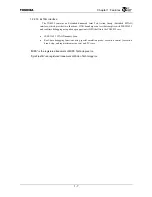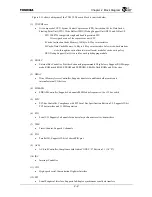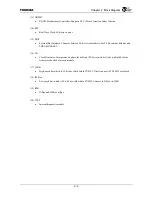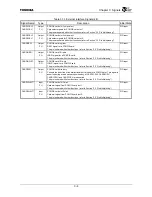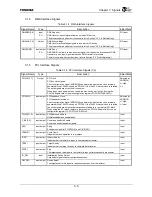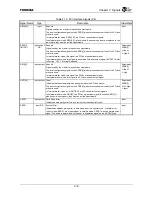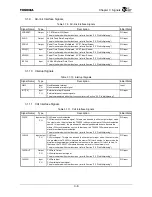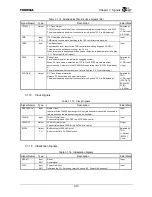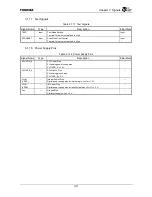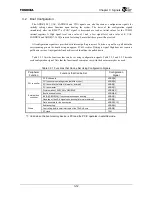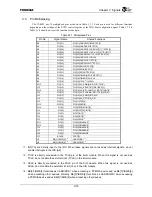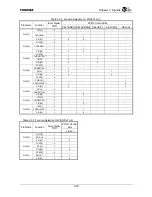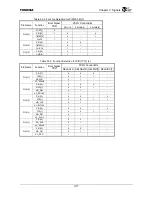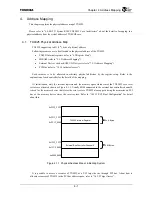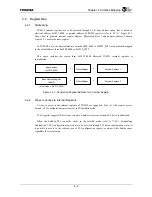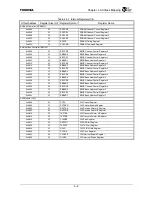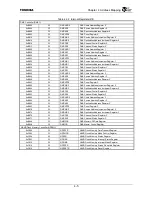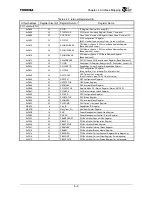
Chapter 3 Signals
3-9
3.1.12 SPI Interface Signals
Table 3.1.12 SPI Interface Signals
Signal Name
Type
Description
Initial State
SPICLK Output
PU
SPI Clock
This pin is used for a data clock to or from an SPI slave device.
The pin is shared with other functions (refer to Section "3.3 Pin Multiplexing").
PIO input
SPIOUT Output
PU
SPI Data Output
This signal contains data to be shifted to an SPI slave device.
The pin is shared with other functions (refer to Section "3.3 Pin Multiplexing").
PIO input
SPIIN Input
PU
SPI Data Input
This signal contains data to be shifted from an SPI slave device.
The pin is shared with other functions (refer to Section "3.3 Pin Multiplexing").
PIO input
3.1.13 NAND Flash Memory Interface Signals
Table 3.1.13 NAND Flash Memory Interface Signals
Signal Name
Type
Description
Initial State
ND_ALE
Output
NAND Flash Address Latch Enable
ALE signal for NAND flash memory.
The pin is shared with other functions (refer to Section "3.3 Pin Multiplexing").
PIO input
ND_CLE
Output
NAND Flash Command Latch Enable
CLE signal for NAND flash memory.
The pin is shared with other functions (refer to Section "3.3 Pin Multiplexing").
PIO input
ND_CE
*
Output
NAND Flash Chip Enable
CE signal for NAND flash memory.
The pin is shared with other functions (refer to Section "3.3 Pin Multiplexing").
PIO input
ND_RE
*
Output
NAND Flash Read Enable
RE signal for NAND flash memory.
The pin is shared with other functions (refer to Section "3.3 Pin Multiplexing").
PIO input
ND_WE
*
Output
NAND Flash Write Enable
WE signal for NAND flash memory.
The pin is shared with other functions (refer to Section "3.3 Pin Multiplexing").
PIO input
ND_R/B
*
Input
NAND Flash Ready/Busy
Ready/Busy signal for NAND flash memory.
The pin is shared with other functions (refer to Section "3.3 Pin Multiplexing").
PIO input
3.1.14 Extended EJTAG Interface Signals
Table 3.1.14 Extended EJTAG Interface Signals (1/2)
Signal Name
Type
Description
Initial State
TCK Input
PU
JTAG Test Clock Input
Clock input signal for JTAG.
TCK is used to execute JTAG instructions and input/output data.
Input
TDI/DINT
*
Input
PU
JTAG Test Data Input/Debug Interrupt
When PC trace mode is not selected, this signal is a JTAG data input signal. It is used
to input serial data to JTAG data/instruction registers.
When PC trace mode is selected, this signal is an interrupt input signal used to cancel
PC trace mode for the debug unit.
Input
TDO/TPC[0]
Output
JTAG Test Data Output/PC Trace Output
When PC trace mode is not selected, this signal is a JTAG data output signal. Data is
output by means of serial scan.
When PC trace mode is selected, this signal outputs the value of the noncontiguous
program counter in sync with the debug clock (DCLK).
Input
Summary of Contents for TMPR4925
Page 1: ...64 Bit TX System RISC TX49 Family TMPR4925 Rev 3 0 ...
Page 4: ......
Page 15: ...Handling Precautions ...
Page 16: ......
Page 18: ...1 Using Toshiba Semiconductors Safely 1 2 ...
Page 40: ...3 General Safety Precautions and Usage Considerations 3 18 ...
Page 42: ...4 Precautions and Usage Considerations 4 2 ...
Page 43: ...TMPR4925 ...
Page 44: ......
Page 54: ...Chapter 1 Features 1 8 ...
Page 58: ...Chapter 2 Block Diagram 2 4 ...
Page 88: ...Chapter 4 Address Mapping 4 12 ...
Page 226: ...Chapter 8 DMA Controller 8 58 ...
Page 260: ...Chapter 9 SDRAM Controller 9 34 ...
Page 480: ...Chapter 15 Interrupt Controller 15 32 ...
Page 554: ...Chapter 19 Real Time Clock RTC 19 8 ...
Page 555: ...Chapter 20 Removed 20 1 20 Removed ...
Page 556: ...Chapter 20 Removed 20 2 ...
Page 564: ...Chapter 21 Extended EJTAG Interface 21 8 ...
Page 580: ...Chapter 22 Electrical Characteristics 22 16 ...
Page 588: ...Chapter 24 Usage Notes 24 2 ...

